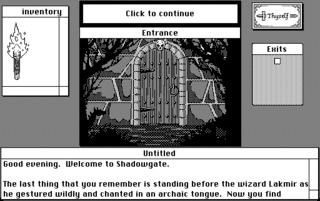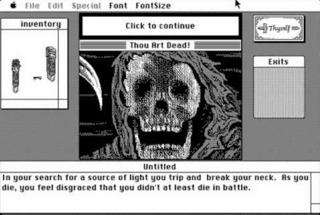The return of Shadowgate is almost here. Originally released on the Macintosh in 1987, Shadowgate, like many point-and-click adventures of the time, was brutally difficult. There was no way around the fact that you were going to die and die and die again, as you ventured through the perilous Castle Shadowgate on your quest to defeat the evil warlock lord. The game didn't just kill you. It delighted in killing you. Picking up an innocent-looking candle, for instance, could result in a trap door opening beneath your feet. "As you fall into darkness," the game's text read, "you tell yourself that there must be a bottom to this pit. Your suspicions are confirmed as your head smashes into stone!"
You could almost hear the game itself laughing at you. At the time, this only made me grit my teeth, pick myself up, and come at the game again, more determined than ever to succeed. There were so many ways for the game to kill you, most accompanied by their own humorous and insulting bit of text, that finding them became an accomplishment in itself, a morbid reward for my explorations and experimentations, all just part of the game.
Historian Reacts To Manor Lords MultiVersus – Official The Joker Character Reveal Trailer | “Get a Load of Me” Sonic Rumble - Official Announcement Trailer BPM x ROBOBEAT Crossover Gameplay Trailer l Coming May 14th Dead by Daylight | Official Horror In Our Hearts Trailer Marvel Rivals - Hela - 'Queen of Hel' | Character Gameplay Reveal Trailer Nintendo World Championships: NES Edition — Announcement Trailer Gundam Breaker 4 - Official Release Date Gameplay Overview Trailer AEW: Fight Forever | Official Season Pass 4 Trailer Solo Leveling: Arise - Global Launch PV: Game On A Whole New Level! No Rest For The Wicked Is Brutal And Ambitious, But A Little Confused | Early Access Impressions Rocket Knight Re-Sparked! Collection | Pre-Order Trailer
Please enter your date of birth to view this video
By clicking 'enter', you agree to GameSpot's
Terms of Use and Privacy Policy
But point-and-click adventure game design has shifted so much in the decades since Shadowgate first debuted. Interfaces have been streamlined. You often can only try to use things in ways that make sense, but Shadowgate is a game in which you can spend plenty of time attempting to use any item in your inventory in any way that is available to you. Want to see what the game says if you click the "eat" command and then click that key in your inventory? Go ahead! Nobody's watching your noble hero as he sticks that big metal key into his mouth.

More significant to the genre than the evolution of interfaces is that adventure game design has moved away from the kill-the-player-constantly approach that typified games of the Shadowgate era. But it was clear from the look I got at the updated Shadowgate recently that it is staying true to this aspect of the original. The game even encourages you, through achievements, to poke and prod everything and find all the hidden ways to die in the game. There are difficulty levels that change the puzzle structure to make the game more accommodating to new players, but death and failure appear to still be a core part of the Shadowgate experience.

I grew up with adventure games like this, and I can see the appeal in them, but I wonder if this design philosophy can still be relevant today, when audiences are so used to more streamlined adventure games in which fail states are rare or nonexistent. On the other hand, we do see players flocking to games in other genres that don't shy away from killing players constantly, including Dark Souls, Spelunky, and Super Meat Boy. So perhaps there is a place in today's world for this kind of point-and-click adventure game.
Do you think there's a place for a game like Shadowgate today? Will it make for a refreshingly difficult departure from the current norm, or will it seem frustrating and outdated? I'll find out how I feel about it when Shadowgate is released in August, but in the meantime, let me know what you think in the comments below.